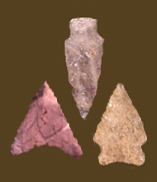
|
KIRK SERRATED
Chronology The Kirk Serrated point dates to the Early Archaic and possibly Middle Archaic periods. Coe (1964) suggests that the Kirk Serrated is younger than the Kirk Corner Notched and Kirk Stemmed, but overlaps them in date. Justice (1987) indicates that the Kirk Serrated and Stemmed are largely coeval, 8900 to 8000 BP (approximately 8100-7025 BC in calendar years). The Rose Island site in Tennessee produced a radiocarbon date of 6070 +/- 190 BC (roughly 7060 BC) in association with the Kirk Serrated (Chapman 1975). At the West Blennerhassett site in West Virginia, multiple hearths associated with the Kirk Serrated were radiocarbon dated to between 6125 and 5810 BC (7075-6675 BC in calendar years) (Johnson et al. 2007). McAvoy and McAvoy (1997) place the point at about 8000 to 7700 BP (approximately 7025-6550 BC) along the Nottoway River in Virginia. At the Pig Point site in Anne Arundel County, Maryland, two possible Kirk points (Corner Notched and Stemmed) were recovered in a layer that produced radiocarbon dates ranging from 7530 +/- 50 BP to 7290 +/- 50 BP, or approximately 6400-6200 BC (Luckenbach 2011a). This is considerably younger than expected, but in the Northeast radiocarbon dates have been reported that suggest that many Early Archaic point types there are as much as 1500-2000 years younger than their equivalents in the Southeast (Funk 1993; Kent 1996). Description Blade: The blade is long, narrow, and relatively thick. The sides are always straight or nearly straight, and deeply serrated. Haft Element: The base is usually straight and blunt, but occasionally thinned and concave. The stem is always broad and nearly square. The width of the stem is usually about two-thirds of the width of the blade. Size: Length ranges from 40 to 120 mm, with an average of 70 mm. Width ranges from 20 to 35 mm, with an average of 30 mm. Thickness ranges from 5 to 12 mm, with an average of 9 mm. Technique of manufacture: The basic blade appears to have been made with broad, shallow percussion flakes. The edges were then shaped by pressure flaking, and the serrations were made as a final step. The short flake scars produced by the serrations indicate that this was done after the basic blade had been shaped. Material: Data on the Kirk Serrated is not very extensive from Maryland. Coe (1964) found that all three Kirk types were made from the same materials at the Hardaway site in North Carolina. At the Cactus Hill site in Virginia, 67% of 33 Kirk Serrated points were quartzite, 15% rhyolite, 12% silicified slate, and 6% quartz (McAvoy and McAvoy 1997). Discussion Defined in Literature Coe (1964) originally defined the type based on points recovered from the Hardaway site in the Piedmont of North Carolina. References |
![]()
Search by Shape:
(See Projectile Point Typology) |

|
Thank you for visiting our website. If you have any
questions, comments, Copyright © 2002 by |

|

 Defining Attributes
Defining Attributes